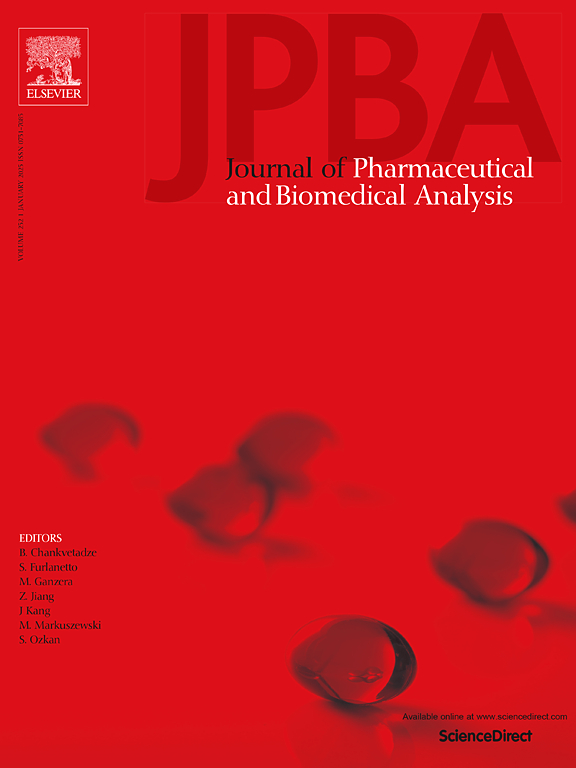UPLC-Q-TOF/MS-based study on chemical composition, in vivo metabolites, and tissue distribution of ethanol extract of Ganoderma lucidum
IF 3.1
3区 医学
Q2 CHEMISTRY, ANALYTICAL
Journal of pharmaceutical and biomedical analysis
Pub Date : 2025-04-12
DOI:10.1016/j.jpba.2025.116886
引用次数: 0
Abstract
Ganoderma lucidum (G. lucidum), a medicinal fungus, exhibits diverse pharmacological effects against many diseases. Studies have shown that the ethanol extract of G. lucidum (GLEE), which is rich in triterpenoids, possesses significant anti-carcinogenic effects. Early research focused solely on the pharmacokinetics and metabolism of individual triterpenoids in normal rodents. However, no research has examined the distribution of prototype compounds and metabolites of GLEE in multiple tissues, plasma, or tumor tissue. In this study, ultra-performance liquid chromatography-quadrupole time-of-flight mass spectrometry (UPLC-Q-TOF/MS), combined with the Global Natural Products Social Molecular Networking (GNPS) platform and UNIFI software, was employed to identify and quantify the chemical composition of GLEE. A total of 105 compounds were identified, including 100 triterpenoids and 5 fatty acids, with 18 high-content monomers quantitatively analyzed. Following six weeks of GLEE administration in tumor-bearing nude mice, 42 prototype compounds and 24 metabolites were identified across plasma, tumors, and eight tissues, including small intestine, stomach, liver, heart, lung, kidney, spleen, and colon. Notably, ganoderic acids A, B, C1, F, and H were the most widely distributed compounds across these tissues. The metabolism of GLEE involves both phase I and phase II reactions. This study is the first to provide a comprehensive profile of GLEE’s chemical composition, distribution, and metabolism, revealing the potential active triterpenoids responsible for its anti-cancer effects. Our findings provide a foundation for future studies focused on the pharmacological mechanisms of these compounds, offering new insights into the therapeutic potential of G. lucidum in cancer treatment.
基于UPLC-Q-TOF/ ms的灵芝乙醇提取物化学成分、体内代谢产物及组织分布研究
灵芝(Ganoderma lucidum)是一种药用真菌,对多种疾病具有不同的药理作用。研究表明,灵芝醇提物(GLEE)含有丰富的三萜,具有显著的抗癌作用。早期的研究仅仅集中在正常啮齿类动物个体三萜的药代动力学和代谢上。然而,目前还没有研究考察GLEE原型化合物和代谢物在多种组织、血浆或肿瘤组织中的分布。本研究采用超高效液相色谱-四极杆飞行时间质谱(UPLC-Q-TOF/MS)技术,结合全球天然产物社会分子网络(GNPS)平台和UNIFI软件,对GLEE的化学成分进行鉴定和定量。共鉴定出105种化合物,其中100种为三萜,5种为脂肪酸,18种为高含量单体。在给荷瘤裸鼠注射六周GLEE后,在血浆、肿瘤和包括小肠、胃、肝、心、肺、肾、脾和结肠在内的八种组织中鉴定出42种原型化合物和24种代谢物。值得注意的是,灵芝酸A、B、C1、F和H是在这些组织中分布最广泛的化合物。GLEE的代谢包括I期和II期反应。这项研究首次提供了GLEE的化学成分、分布和代谢的全面概况,揭示了其抗癌作用的潜在活性三萜。我们的研究结果为进一步研究这些化合物的药理机制奠定了基础,并对灵芝治疗癌症的潜力提供了新的见解。
本文章由计算机程序翻译,如有差异,请以英文原文为准。
求助全文
约1分钟内获得全文
求助全文
来源期刊
CiteScore
6.70
自引率
5.90%
发文量
588
审稿时长
37 days
期刊介绍:
This journal is an international medium directed towards the needs of academic, clinical, government and industrial analysis by publishing original research reports and critical reviews on pharmaceutical and biomedical analysis. It covers the interdisciplinary aspects of analysis in the pharmaceutical, biomedical and clinical sciences, including developments in analytical methodology, instrumentation, computation and interpretation. Submissions on novel applications focusing on drug purity and stability studies, pharmacokinetics, therapeutic monitoring, metabolic profiling; drug-related aspects of analytical biochemistry and forensic toxicology; quality assurance in the pharmaceutical industry are also welcome.
Studies from areas of well established and poorly selective methods, such as UV-VIS spectrophotometry (including derivative and multi-wavelength measurements), basic electroanalytical (potentiometric, polarographic and voltammetric) methods, fluorimetry, flow-injection analysis, etc. are accepted for publication in exceptional cases only, if a unique and substantial advantage over presently known systems is demonstrated. The same applies to the assay of simple drug formulations by any kind of methods and the determination of drugs in biological samples based merely on spiked samples. Drug purity/stability studies should contain information on the structure elucidation of the impurities/degradants.

 求助内容:
求助内容: 应助结果提醒方式:
应助结果提醒方式:


